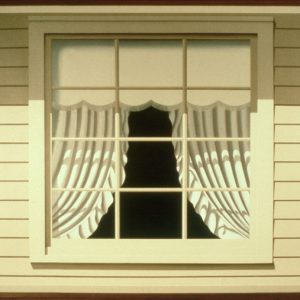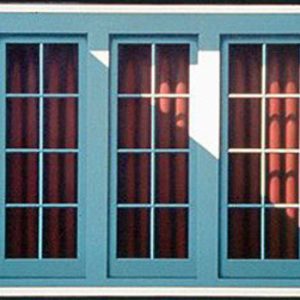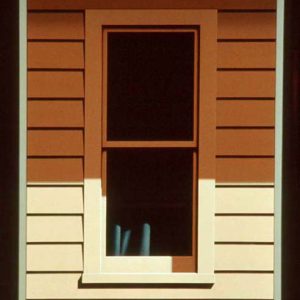calsfoundation@cals.org
Al Allen (1925–2008)
aka: Alvin Lee Allen Jr.
Alvin Lee (Al) Allen Jr. was a painter whose contributions to Arkansas culture were his artwork, his teaching, his development of the Department of Art at the University of Arkansas at Little Rock (UALR), and two autobiographical books. His mature work was of idealized man-made structures, often with windows, bathed in bright light. His style presents realistic subjects in a classical and abstract way.
Al Allen was born on November 29, 1925, the only child of Carrie Allen and Alvin Lee Allen of Steele, Missouri. His father was an automobile dealer in nearby Caruthersville; his mother was a seamstress who later worked for Goldsmith’s department store in Memphis, Tennessee. The Missouri Bootheel landscape was an environment of vast space, emptiness, and silence, with gray shacks surrounded by fields of zinnias. In some of the shacks, women quilted using geometrically organized patterns. This quality would find a place in Allen’s paintings.
Allen was raised in Memphis, where his interest in art developed. After graduation from Central High School in 1944, he served in the navy during World War II, using his artistic skills in the top-secret Terrain Model Workshop. Using aerial photographs of Pacific islands, Allen and other naval specialists stationed in Hawaii designed three-dimensional models of sites such as Iwo Jima used to plan invasions. In 1945, he married Juanita Jowers; they had one child, Eric Thomas.
In 1946, Allen enrolled in Louisiana State University (LSU). Among his teachers were O. Louis Guglielmi and Ralston Crawford, an important American artist who continued the Precisionist style associated with his teacher Charles Sheeler. Completing his undergraduate studies in 1950, Allen returned to Memphis to teach at Treadwell High School. Meanwhile, he pursued an MA degree at LSU, completing that—then the highest academic degree possible for artists—in 1954. The next year, he joined the faculty of Union University in Jackson, Tennessee. During his tenure there, he spent the 1957–58 academic year at Stanford University in California, supported by a grant from the Danforth Foundation, which also allowed him to visit the University of Minnesota at Duluth, the University of Arizona in Tucson, and the University of Colorado at Boulder.
Allen’s paintings in the decade after his LSU studies were in an abstract expressionist vein. In the mid-1960s, Allen, motivated by the writings of Albert Schweitzer and others, sought a form of expression that would have a more universal appeal. He traveled the rural mid-South, camera in hand, seeking what he called enhanced visual moments, perhaps special light patterns or shapes that stood out. Back in his studio, he edited and refined each visual moment in the resulting paintings. He believed his works needed to have a sense of mystery. An example is Hayloft: Recollection (1970), which includes painted parts and salvaged materials from old buildings; this juxtaposition evokes the human activities and work associated with barns and rural dwellings, even as the artist uses a sophisticated and simplified composition to organize the pieces. Other works of the period evoke a rural, Southern experience: Barn: Inside-Outside (1968, Fort Smith Regional Art Museum), Aunt Sally’s House (1969, North Little Rock Women’s Club), and Morning (1970, Arkansas Arts Center—now the Arkansas Museum of Fine Arts).
Allen’s philosophical interests supported his role as art teacher. He believed strongly that art should enhance and enlarge the spirit of anyone who sees it. He worked steadily in his corner of the world, sensitive to larger places and problems but finding fulfillment in his art and in working with others. His humanitarian values can be seen through the scale of his paintings, the selection of subjects, and the balance between realism and sophisticated abstraction. Subjects included porch posts, shingles, siding, and especially windows. Morning Musing (1984, Arkansas Arts Center), for example, shows three tall windows of eight panes each, with a strong light dividing the picture diagonally into a dark and light area. The closed curtains seen through the windows give an air of the mysterious and unknown; the familiarity of the scene and size (46″ x 63.5″) of the picture allow viewers to think of this on a human scale. While the work is based on reality, the simplification of forms, the lack of textural details, and the classically balanced forms make this a highly sophisticated work.
In 1968, when Little Rock University was planning to expand and join the University of Arkansas system to become UALR (later called UA Little Rock), Allen was invited to chair and develop the art department. Not only did he teach painting and other studio subjects, he was a teacher and advocate of art appreciation classes for non-majors. He built the department to include full-time faculty with degrees in a variety of studio areas, art history, and art education. He turned the chair responsibilities to others in 1978 but remained an active member of the teaching faculty until he retired in 1992. In 1985, he was given the title of Professor and University Artist-in-Residence.
Among the awards Allen received were the Brooks Memorial Purchase Award for Winter Waiting in 1973; the Purchase Award at the Mid-American National Exhibition in 1980; inclusion in the Mid-America Arts Alliance exhibition for Ten Mid-American Artists (1981); selection for the dedicatory exhibition for the grand opening of the Tarble Art Center in Charleston, Illinois (1982); and the Grand Award of the Delta Art Exhibition at the Arkansas Arts Center for Morning Musing (1984). He received a retrospective exhibition at UALR in 1990.
Allen’s friends and students always recognized that he had an additional talent as a storyteller. In 1991, he published his first book, Roads that Seldom Curve: Growing up along the Mississippi, a compilation of stories about growing up in the Missouri Bootheel and Memphis, and other early experiences. The book’s success led to a similar second publication, Zinnias Grow on Either Side of the River (1995).
After he retired, Allen and his wife lived in Little Rock (Pulaski County), later moving to the Kansas City, Missouri, area to be with their son. He died there on February 14, 2008, and was cremated.
Allen’s works are in a number of collections belonging to museums, colleges and universities, and private individuals, including the Arkansas Museum of Fine Arts, Brooks Museum (Memphis), High Museum (Atlanta), and the Joslin Art Museum (Omaha). UA Little Rock has several works in its permanent collection and many others on loan from the artist. Both former U.S. senators Dale Bumpers and David Pryor displayed Allen’s works in their Washington DC offices, and during Bill Clinton’s presidency, two of Allen’s works were hung in the White House.
For additional information:
Allen, Al. Roads that Seldom Curve: Growing up along the Mississippi. Compiled by Jeanie Flake Frauenthal. Little Rock: August House, 1991.
———. Zinnias Grow on Either Side of the River. Fayetteville, AR: M & M Press, 1995.
Martin, Floyd W., and Marcia Wilkinson. “Al Allen and the Enhanced Visual Moment.” In Al Allen/Decennial II: Selected Paintings from the Eighties. Little Rock: University of Arkansas at Little Rock Galleries, 1990.
Wilkinson, Marcia. Recent Work of Al Allen. MA thesis, University of Arkansas at Little Rock, 1991.
Floyd W. Martin
University of Arkansas at Little Rock
 Arts, Culture, and Entertainment
Arts, Culture, and Entertainment Late Breakfast
Late Breakfast  Quintette Blue
Quintette Blue  Winter
Winter 




Comments
No comments on this entry yet.